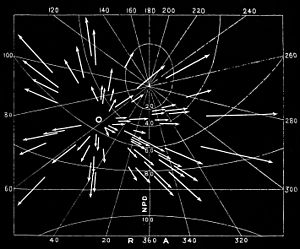Meteor shower facts for kids
A meteor shower is a cool event where you see lots of meteors (also called "shooting stars") streaking across the night sky. It looks like they all come from one spot! These bright streaks happen when tiny bits of space rock, called meteoroids, zoom into Earth's atmosphere super fast. Most of them are smaller than a grain of sand, so they burn up high above us and never reach the ground.

Contents
How Do Meteor Showers Happen?
A meteor shower happens when Earth passes through a trail of dusty bits left behind by a comet. Imagine a comet as a "dirty snowball" made of rock and ice. Comets travel around the Sun in a path called an orbit.
Every time a comet gets close to the Sun, some of its ice turns into gas. This releases tiny pieces of rock and dust, which are the meteoroids. These meteoroids spread out along the comet's orbit, forming a long "dust trail" in space. When Earth crosses through one of these dust trails, we see a meteor shower!
Where Do the Meteoroids Come From?
Many meteor showers we see come from comets that have broken apart over time. For example, the Quadrantids and Geminids meteor showers come from objects that look more like asteroids than typical comets. Scientists believe these objects, named 2003 EH1 and 3200 Phaethon, broke apart a long time ago.
When these objects broke, they created lots of tiny dust, sand, and pebble-sized pieces. These pieces then spread out along their orbits. When Earth's path crosses these dense trails, we get a spectacular meteor shower.
Famous Meteor Showers
Some meteor showers are more famous and active than others. They happen at the same time each year.
The Perseids Meteor Shower
The Perseids are one of the most visible meteor showers every year. They usually peak around August 12th. During this time, you might see more than one meteor every minute! NASA has a helpful tool to figure out how many meteors you might see from your location.
The Leonids Meteor Shower
The Leonid meteor shower peaks around November 17th each year. About every 33 years, the Leonids put on a really big show called a "meteor storm." During a storm, you can see thousands of meteors per hour!
The term "meteor shower" was first used after a huge Leonid storm in November 1833. People realized that all the meteors seemed to come from one point in the sky, near the star Gamma Leonis. The most recent Leonid storms happened in 1999, 2001, and 2002. When the Leonids are not "storming," they are usually less active than the Perseids.
Images for kids
-
Mars meteor by MER Spirit rover
See also
 In Spanish: Lluvia de meteoros para niños
In Spanish: Lluvia de meteoros para niños









